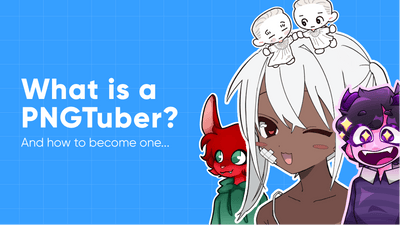
As we explore the boundaries of digital creativity, VTubers stand at the forefront of a new era in entertainment. Originating from early virtual characters like Gorillaz, Hatsune Miku, and Crazy Frog, VTubers have evolved from novelty acts into a major cultural phenomenon. These virtual influencers harness cutting-edge technology to forge identities that captivate audiences worldwide, marking a shift from the traditional quest for internet fame to embracing semi-anonymity and digital personas.
This article will guide you through the fascinating world of VTubers. You'll learn what VTubers are, how VTubing works, the software that powers these digital personalities, and how you can step into the role of a VTuber yourself. Whether you're looking to become a VTuber or simply curious about this digital trend, you'll find valuable insights and practical advice to navigate this innovative form of content creation
What is a VTuber?
A VTuber is a content creator who uses a digital avatar instead of showing their real face. These avatars can range from anime-style characters to realistic 3D models, all created using computer graphics and motion capture technology.
Although the name originated from YouTube, VTubers are found on various streaming platforms including Twitch, TikTok, as well as regional platforms like Niconico and BiliBili. The concept of VTubers started in Japan in the mid-2010s and has since gained global popularity, particularly since 2020.
VTubers may create detailed backstories for their characters to engage their audience, but not all choose to do so. Some simply enjoy the creative and fun aspects of embodying a digital persona without developing an elaborate backstory. This approach allows to appeal to a wide range of viewers with different interests. VTubers not only entertain but also offer a unique way for creators to engage with their audience without revealing their true identities. This anonymity can be especially appealing for those who prefer privacy but still want to connect with fans and build a community.
Moreover, entering the VTuber scene has become quite accessible. With basic motion capture tools or even a regular webcam and avatar creation software, anyone can start their own VTuber channel. This accessibility encourages a diverse range of creators to experiment with their digital personas and find unique niches within the VTuber community.
How VTubing Works
The process begins with the creation of an avatar, which can range from simple 2D characters to more detailed 3D models, depending on the creator’s preference and technical skills. This avatar acts as the VTuber's identity on various streaming platforms like Twitch, YouTube, or TikTok.
To animate these avatars, VTubers use motion capture tools. These can be as advanced as full-body suits used in professional gaming or as simple as webcams that capture facial expressions and head movements. This data is processed by animation software that matches it to the avatar, allowing it to mimic the creator’s movements almost instantly.
For streaming, VTubers integrate this animated avatar into live broadcasts using software like OBS Studio. This setup lets the avatar interact with viewers by chatting, reacting, and performing just as a real person would. The software handles the technical side, ensuring that the avatar's movements are smoothly broadcasted to the audience.

As you dive into the world of VTubing, consider enhancing your virtual presence with our Customizable VTuber Model for Vtube Studio. This model offers extensive customization options, allowing you to tailor your avatar's clothing, accessories, and hairstyles to reflect your unique style. Whether you’re a beginner or a seasoned VTuber, our model provides the tools you need to stand out and create a memorable digital persona. Elevate your streams and engage your audience with a fully personalized avatar that truly represents you.
VTuber Software
Understanding the right software is essential if you’re interested in becoming a VTuber. There are several types of software needed, depending on whether you're creating 2D or 3D avatars.
2D VTuber Software
-
Creation and Rigging: Live2D Cubism is a powerful tool for creators looking to bring flat illustrations to life. It enables detailed rigging and animation of 2D graphics, making them move almost as naturally as their 3D counterparts.
-
Real-Time Performance: VTube Studio offers real-time facial tracking and animation capabilities, perfect for live streaming. It translates your expressions and movements onto your 2D avatar during live sessions.
3D VTuber Software
-
Creation and Rigging: VRoid Studio provides a user-friendly interface for those new to 3D modeling, allowing users to create detailed 3D avatars without needing extensive 3D skills.
-
Real-Time Performance: VSeeFace excels in live motion capture and streaming, supporting a broad range of 3D avatar formats and providing advanced tracking features to bring your 3D avatar to life in real time.
If you want to learn more about each software's features, benefits, and how they can fit into your VTubing setup, check out our extended article on the best VTuber software. It's designed to help you make an informed decision and get started with the right tools for your VTuber journey.
How to Become a VTuber?
Step 1: Create Your VTuber Persona
Developing a unique character is the first and most crucial step. Decide on the personality traits, appearance, and backstory that make your VTuber persona stand out. This character can reflect elements of your personality or interests to ensure authenticity and engagement with your audience.
Step 2: Acquire Your VTuber Model
Once your persona and lore are defined, you need to create or acquire a digital model. You can choose between 3D, 2D, and PNG models depending on your preference and technical capability. Options include drawing your own model, commissioning an artist, or purchasing pre-made models from vtuber models marketplaces just like ours. Keep in mind, the quality of the model should be good enough to represent your character effectively but doesn't need to be overly complex when you're just starting out.
Step 3: Set Up Your Streaming Equipment
Essential equipment includes a reliable computer capable of handling gaming, live streaming and running vtuber software at the same time, a good quality microphone, and a camera for motion capture. Proper lighting is also important, especially if you're using facial tracking technology to animate your model. There are plenty of budget-friendly, and you can always upgrade your setup as your channel grows.
Step 4: Download and Setup VTubing Software
To animate your VTuber model, you'll need software like VTube Studio or VSeeFace, which are popular for their ease of use and, motion tracking capabilities. These programs allow you to animate your model in real-time during streams.
Step 5: Select Your Streaming Platform
Choose a platform that fits your content style and where your target audience is most active. Twitch and YouTube are the most common choices due to their large user bases and support for live streaming content.
Step 6: Plan Your VTuber Debut
Your debut stream is your first opportunity to introduce your VTuber persona to the world. It's important to make a strong first impression, so plan a stream that showcases your character's personality and interests. Consider doing a Q&A session to answer questions from viewers or a special performance that highlights your unique talents. Promote your debut in advance on social media and VTuber communities to build anticipation and attract an audience.
Step 7: Create a Content Schedule
Consistency is key in building and maintaining an audience. Develop a content schedule that outlines what days and times you'll be streaming. Your schedule should balance your availability with peak times when your target audience is likely to be online. Stick to this schedule as closely as possible to help your viewers know when to expect new content from you.
Step 8: Engage and Grow Your Community
As you stream, actively engage with your viewers by responding to comments and asking questions. Use social media platforms to connect with your audience outside of streams and to share updates or upcoming events. Consider collaborations with other VTubers to reach a wider audience. As your community grows, listen to their feedback to refine your content and interaction
Wrapping it up
With this guide, you now understand the fundamentals of VTubers, from the technology that drives them to the steps needed to create one yourself. Keep exploring and expanding your skills as you embark on your VTubing journey. Best of luck with your creative adventures!




